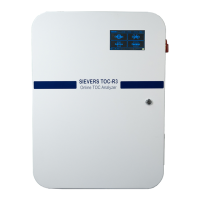PURGEABLE/VOLATILE ORGANIC CARBON (POC/VOC) MEASUREMENT
. . . .. . . ... .... .... .... ..... ..
Sievers TOC-R3 Operation and Maintenance Manual
DLM 95000-01 EN Rev. A 40 © Veolia 2023
NDIR Detector after acidification and purging. This Method is a purchasable option with
TOC by difference. It must be purchased and enabled before it can be used for analysis.
TOC diff Method (TOC)
The TOC by difference (TOC or TOCdiff) Method determines Total Carbon (TC) first
followed by the measurement of the inorganic carbon TIC (Total Inorganic Carbon)
content. This Method is a purchasable option. It must be purchased and enabled before it
can be used for analysis.
The difference TC – TIC represents the TOC contend of the sample. In the differential
method, both total carbon (TC) and total inorganic carbon (TIC) are determined by
separate measurements, TOC calculated by subtracting TIC from TC. The differential
method is suitable for samples in which TIC is less than TOC.
TOC add Method
The TOC by addition (POC/VOC + NPOC) Method first determines POC (Purgeable
Organic Carbon) followed by the measurement of NPOC (Non-Purgeable Organic
Carbon). The sum of POC and NPOC represents the TOCa result of the sample. The
settings on the firmware display this as “TOCa”. This Method is a purchasable option with
POC/VOC. It must be purchased and enabled before it can be used for analysis.
Purgeable/Volatile Organic Carbon (POC/VOC)
Measurement
POC stands for Purgeable Organic Carbon and VOC stands for Volatile Organic
Carbon. Any reference to VOC indicates “POC/VOC”. Any reference to POC also
indicates “POC/VOC”. The Analyzer determines the POC/VOC content in a sample using
an optional Photoionization Detector (PID) with an energy level of less than 10.6 eV
(PID) in the gas stream. The PID specifically measures the contained POCs/VOCs. To
measure the POC/VOC content, the sample is loaded into the Multi-Function Sample
Vessel (MFSV), mixed with acid, and then stripped. The escaping volatile organic carbon
compounds are measured by a PID Detector. The PID Detector’s internal pressure and
temperature monitoring compensates for environmentally induced fluctuations, ensuring
that it always outputs reliable and accurate results. This Method is a purchasable option.
TNb Measurement
The analysis of Total Nitrogen Bound or Total Bound Nitrogen (TNb) also requires a
thermal oxidation process. The bound Nitrogen is converted into Nitric Oxide (NO), which
can be determined with an optional Electrochemical Detector (ECD). A high oxidation
temperature of 1,200 °C (2192 °F) combined with a short residence time in the reactor
favors the reaction of very different Nitrogen components to form NO. The area integral of
the NO detection peak corresponds to the TNb content. The measurement of TNb is of

